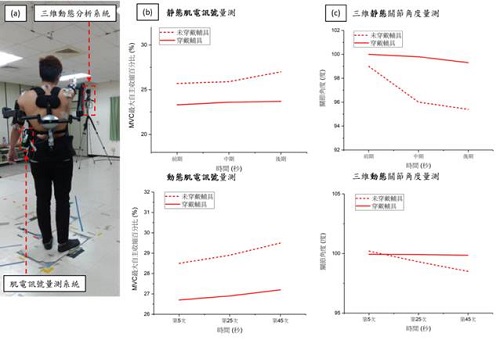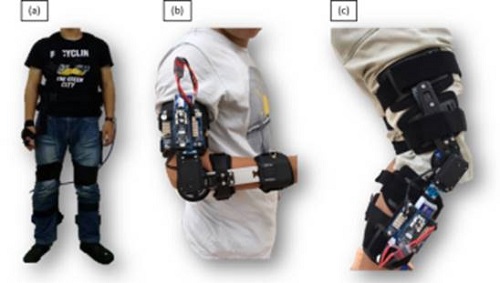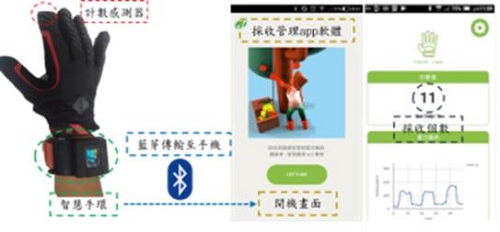In Taiwan, because of aging of agricultural work force and small cultivation areas, many large agricultural machines do not meet the needs of farmers in Taiwan. Therefore, we hope to develop wearable aids with wide application and flexibility for farmers so that they can use less physical strength when harvesting and handling crops. Moreover, we have also developed smart gloves and relevant apps that can transmit the information regarding the harvested quantity in real time to directly connect production and market for improving the overall production efficiency.
Applications of Wearable Intelligent Assistive Device
So far, we have developed two types of wearable assistive device: "Unpowered Wearable Device" and "Powered Wearable Device". These two types of wearable assistive devices have been applied to a mango farm and a papaya farm for test (Figure 1). According to the measurement of the muscle activation index and shoulder joint angle of farmers with and without wearing the wearable assistive device, the differences showed that the wearable assistive device effectively reduced the fatigue and physical loads of farmers during crops harvesting and handling process.
 Figure 1a. Application of the unpowered mechanical assistive device to mango picking; b. application of electrically-controlled unpowered assistive device for papaya picking
Figure 1a. Application of the unpowered mechanical assistive device to mango picking; b. application of electrically-controlled unpowered assistive device for papaya picking Unpowered wearable assistive device
There are two types of unpowered wearable assistive devices. One is based on mechanical assistance (Figure 1a), which provides assistance and support to farmers when they lift their arms during harvesting. The mechanical wearable assistive device offers up to 9 kg assistance force to one arm. The other is electronically-controlled unpowered assistive device (Figure 1b), which is designed for long-term arm lifting, and provides 3 to 5 kg assistance force to one arm.
 Figure 2a.Measurement of comfort level and fatigue level of the farmers wearing the wearable assistive devices; b. static and dynamic electromechanical signal measurement; c. 3D static and dynamic joint angle measurement
Figure 2a.Measurement of comfort level and fatigue level of the farmers wearing the wearable assistive devices; b. static and dynamic electromechanical signal measurement; c. 3D static and dynamic joint angle measurementThe differences in farmers with and without wearing the assistive device are shown quantitatively in Figure 2, wherein Figure 2a shows the myoelectric signal and joint angle of the farmers with and without wearing the assistive device and Figure 2b presents the static and dynamic myoelectric signal data of the subjects. The data clearly indicate that the fatigue of the farmer without wearing the assistive device increased by about 5% at the late stage of the 90-second arm lifting test. Figure 3 shows the results of joint angle test. Without wearing the assistance device, the arm lifting angle was significantly reduced by about 5 degrees. Based on the above test data, wearing the assistive device has been proven to effectively save arm strength and reduce fatigue, and the reduction in joint angle is slower after long-time arm lifting.
 Figure 3. Powered wearable assistive device (a) air-driven wearable assistive device; (b) electricity-driven wearable assistive device for upper limbs;(c) electricity-driven wearable assistive device for lower limbs
Figure 3. Powered wearable assistive device (a) air-driven wearable assistive device; (b) electricity-driven wearable assistive device for upper limbs;(c) electricity-driven wearable assistive device for lower limbsPowered wearable assistive device
We have developed two types of powered assistive devices. One is air-driven and the other is electricity-driven. The air-driven assistive device (Figure 3a) can provide about 3 kg force to one leg through the cylinder, which helps farmers to easily stand up from a bending position while handling crops and reduce the burden on the knees and back. The electricity-driven assistive device (Figures 3b and 3c) assists elbows and knees. It provides a lifting force of about 1.5 kg for one elbow and about 1.5 kg force to one knee for straightening. Moreover, to avoid accidents caused by instant excessive assistive force, an anti-tip feedback mechanism is added to the device.
 Figure 4 Intelligent harvest gloves, bracelets and app management software
Figure 4 Intelligent harvest gloves, bracelets and app management softwareDevelopment of Intelligent Harvest Gloves, Bracelets and App Management Software
In addition to the development of the intelligent agricultural assistive device mentioned above, we also developed intelligent harvest gloves, bracelets and app management software (Figure 4) to save farmers’ time in daily operation. The sensors at the tip of intelligent harvest gloves can collect data in the fruit picking process, and transmit the data to the bracelets for recording and statistics. The OLED screen of the bracelet can instantly display the quantity picked. Afterwards, the bracelets can be connected with smart phones through Bluetooth for uploading the data to the app management software, which will transmit the relevant statistics to the server at the market end.